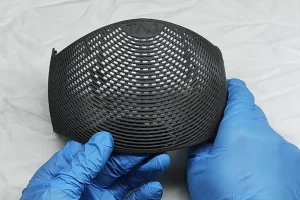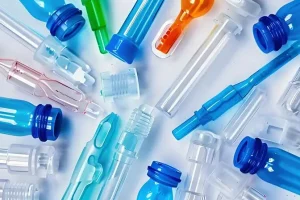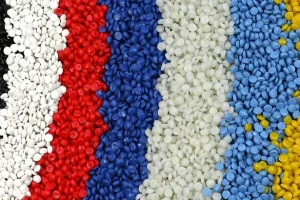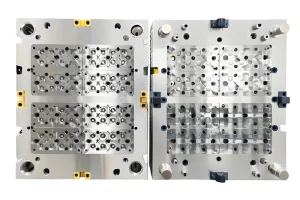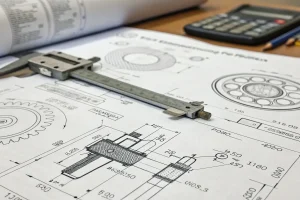Injection molding machine fill time is one of the most crucial factors in injection molding. It is related not only to the quality of the product sold but also directly to the number of sales achieved and the cost of the product. In this regard, the supplied holding pressure is very crucial part of injection molding machine in assessing the time taken to fill the mould hence can be used to optimise and enhance the quality of materials in the injection mould to reduce associated costs. This article will focus on the efficiency of the engineering workplace and calculation of time required to fill the injection molding machine barrel; effect of some factors on filling time and practices of calculations.

Overview of the Injection Molding Process
Injection molding is a process where pressure is used to inject molten plastic into a mold and then allowed to cool so that it solidifies into the required shape. The process includes the following steps:
1. Plasticizing: Thermoplastics are melted into a barrel that forms pellets at high temperatures.
2. Injection: The molten plastic is then pushed into the mold cavity.
3. Packing: Second, pressure is maintained after injection to counteract the tendency of the injected material to shrink.
4. Cooling: Pressure is maintained while the plastic cools and solidifies in the mold.
5. Mold Opening and Part Removal: The part is then removed when the mold opens.
One part of the molding process is the filling time or injection time – the time it takes for the molten plastic to travel from the screw through the barrel and into the mold cavity and is completed.

Importance of Filling Time
Accurate filling time is crucial for injection molding, primarily reflected in the following aspects:
1. Product Quality: The duration used in the ablution process has a significant influence on the quality of the product in terms of surface finish, global tolerances and particularly on the complexity of the cavity of the product. In this case the product will be imperfect – it will have surface defects if the filling time is too long, unstable dimensions if too short, and red or white bubbles inside if too long or short.
2. Production Efficiency: The amount of time required in the production process contributes to an important consideration from the initial production to product placement in the market. It can intensify the working peak and enhance the efficiency if the appropriate time is chosen to fill the equipment.
3. Cost Control: The use of the filling time increase option for the optimization can cut the amount of materials and energy used as well as reduce the cost of production.

Factors Affecting Filling Time
The filling time of the injection molding process is influenced by various factors, mainly including the following aspects:
1. Material Properties: Plastics may have different flow properties; that is, some may melt at a lower temperature, some at a higher temperature; some may be more viscous than others, and some may be of poor flowability than the others, which will consequently make the filling time to vary from one material to the other. For example, high viscosities of material prolong the filling time of a mold.
2. Injection Molding Machine Parameters: The filling time depends strongly on the parameters of the injection molding system, e. g. screw speed, injection pressure or the screw diameter. Increasing the injection speed and pressure can contribute towards minimizing the filling time.

3. Mold Design: The runner diameter, the cantilever distance and number of gate as well as the shape of the mould cavity also affect the filling time. An example of special design of the mold is sometimes it can also compromise the filling time.
4. Process Conditions: Filling time depends on the processing conditions such as the mold temperature; melt temperature; and cooling time. Choosing the right process parameters will help it reduce the time required to fill the pipe.

Methods for Calculating Filling Time
1. Empirical Formula Method
In real life, we often use formulas to calculate filling time. These formulas are usually created by looking at a lot of data and doing some math. Here’s a common formula:
tf =𝑉/𝑄
where:
- tf is the filling time;
- 𝑉 is the volume of the mold cavity;
- 𝑄 is the injection flow rate.
The injection flow rate 𝑄 can be calculated by the following formula:
𝑄=𝐴⋅𝑣
where:
- 𝐴 is the cross-sectional area of the screw diameter;
- 𝑣 is the screw speed.

2. Rheological Model Method
The rheological model method is based on the rheological properties of the plastic material. It calculates the material’s flow behavior in the mold to determine the filling time. Common rheological models include the Newtonian fluid model and the non-Newtonian fluid model.
Newtonian Fluid Model
For Newtonian fluids, the flow behavior satisfies the following formula:
𝜏=𝜂⋅𝛾˙
where:
- τ is the shear stress;
- η is the dynamic viscosity;
- γ˙ is the shear rate.
In the Newtonian fluid model, the filling time can be calculated by the following formula:
𝑡𝑓=𝑉/(𝐴⋅𝑣)

Non-Newtonian Fluid Model
For non-Newtonian fluids, the flow behavior is more complex, often described by the power-law fluid model. The flow behavior of the power-law fluid model is described by the following equation:
𝜏=𝑘⋅𝛾˙𝑛
where:
- 𝑘 is the flow consistency index;
- 𝑛 is the flow behavior index.
In the non-Newtonian fluid model, the calculation of filling time needs to consider the material’s nonlinear flow characteristics, which is usually done by numerical simulation.

3. Numerical Simulation Method
The best way to find out how long it takes to fill a mold is to use math. You can use special computer programs like Moldflow, Moldex3D, and others to do this. These programs use math to figure out how the plastic flows into the mold.
Here’s how you do it:
1. Modeling: Some have the ability of using a 3D model of the mold with all the parts like the cavities, gates, and runners.
2. Setting Material Parameters: You have to enter values that indicate to the program how the plastic is moved and how hot the plastic is.

3. Setting Process Parameters: You have to type in data that tells the program how to operate the machine for example how forceful to push the plastic how hot to cook the mould.
4. Running Simulation: This means that it is a prerequisite to run the computer program to visualize what happens when the plastic is introduced into the mold.
5. Analyzing Results: You have to evaluate the answers the program gives you as for the time needed to fill the mold and how high the temperature is.
Numerical simulation is better than analytical method because it is accurate for complex shapes and materials with complicated properties but it needs special software and more computing power.

4. Experimental Verification Method
When calculating the filling time with the experimental verification method, I would like to mention that it is a method of estimating the filling time. For the practical taste manufacturing process, the filling time is increased in a small step for an appropriate number of times until the optimal level is achieved.
The steps of the experimental verification method are as follows:The steps of the experimental verification method are as follows:
1. Preliminary Parameter Setting: First evaluate the design parameters for example injection pressure or injection speed based on theoretical models or computational simulations.

2. Trial Production: Carry out a trial and the time it takes to fill the mold and the quality of the parts are recorded, with a view to study the degree of accuracy of the results obtained from the integral model for the prediction of the filling of the mold and the quality of the parts.
3. Adjust and Optimize: Assess the trial results, formulate a model to accurately change the process parameters or optimization of filling time.
4. Determine Parameters: When a number of tests and adjustments have been made, establish the ideal fill time.
The strength of the experimental verification method is that it is straightforward and replicable but, however, it is costly and takes a long time to conduct the experiment.

Practical Application Case Analysis
To better understand the methods for calculating filling time, we will analyze a practical case.
Case Background
A company needs to make a batch of plastic housing products. The material is polypropylene (PP). The mold design is as follows:
- Cavity volume: 200 cm³
- Gate diameter: 2 mm
- Number of gates: 1
Injection molding machine parameters are as follows:
- Screw diameter: 30 mm
- Injection speed: 100 mm/s

Calculation Steps
1. Empirical Formula Method:
First, calculate the injection flow rate:
A=π⋅(D/2)2=π⋅(30/2)2=706.86 mm2
𝑄=𝐴⋅𝑣=706.86 mm2⋅100 mm/s=70686 mm3/𝑠=70.686 cm3𝑠
Then, calculate the filling time:
𝑡𝑓=𝑉/𝑄=200 cm3/70.686 cm3/𝑠≈2.83s

2. Rheological Model Method:
Assuming polypropylene behaves as a Newtonian fluid at this temperature, and its flow behavior can be simplified as:
𝑡𝑓=𝑉/(𝐴⋅𝑣)=200 cm3/(706.86 mm2⋅100 mm/s)=200 cm3/70.686 cm3/𝑠≈2.83s
3. Numerical Simulation Method:
Using Moldflow software to simulate the mold and material parameters, set the process conditions, and run the simulation. The filling time was about 2.85 seconds.
4. Experimental Verification Method:
Conducting trial production recorded a filling time of approximately 2.8 seconds. After multiple adjustments, the final determined filling time was 2.8 seconds.

Strategies for Optimizing Filling Time
While it’s important to calculate filling time accurately, it’s also important to optimize filling time. Here are some strategies for optimizing filling time:
Optimizing Injection Molding Machine Parameters
1. Injection Speed: The injection speed you chose is good because you minimized the filling time and also you are not making the material to get mixed up when moving through the machine at a high speed.
2. Injection Pressure: When it’s low, it indicates that it will take a longer time to fill the mold with the liquid but when it’s high, that means that you can fill the liquid a little fastly but if it’s too high, then you might end up cracking the mold or making flash.
3. Screw Design: Alterations like making the screw have higher compression can also help to melt the material more and mix it better so that as the mold is filled.

Improving Mold Design
1. Gate Design: They said that if you add more gates or move the gates around, you can make the plastic flow better and fill up faster.
2. Runner Design: If you make the runners narrower, make them shorter, and change their shape, the plastic will flow better.
3. Vent Design: If you put more holes in the mold so the air can get out of the mold better, you won’t get bubbles and the plastic will fill up better.

Adjusting Process Parameters
1. Mold Temperature: If you increase the mold temperature, it will slow down how fast the material cools and make the packing time longer.
2. Melt Temperature: If you increase the melt temperature, it will lower the viscosity of the material and make it flow better when it fills the mold.
3. Injection Time: You have to make sure you don’t set the injection time too long or too short, or you’ll get bad parts.

Using Advanced Technology
1. Numerical Simulation: Research on numerical simulation technology can help us find out the filling problem early, and adjust the process parameters and mold design.
2. Intelligent Control: We can use intelligent control to optimize the injection molding machine, such as using a pressure control system to control the pressure in the injection system, and fine-tuning the injection process to improve the stability and accuracy of the filling process.
3. New Materials: Developing new high-flow materials can effectively reduce the filling time and increase production efficiency.

Practical Application Case Analysis (Continued)
To better understand the optimization strategies for filling time, let’s continue analyzing the previous practical case.
Optimizing Injection Molding Machine Parameters
After conducting some experiments, we found that by increasing the injection speed to 150 mm/s, we could significantly reduce the filling time without sacrificing product quality. Here are the new filling times we calculated:
𝑄=706.86 mm2⋅150 mm/s=106029 mm3/𝑠=106.029 cm3/𝑠
𝑡𝑓=200 cm3/106.029 cm3/𝑠≈1.89s

Improving Mold Design
Numerical simulation showed that adding another gate would be a good way to improve material flow and reduce filling time. We modified the mold to add one more gate and ran the filling simulation again. The result was a filling time of about 1. 75 seconds.
Adjusting Process Parameters
We also ran an experiment with a mold temperature of 80°C and a melt temperature of 220°C. The total filling time was about 1. 70 seconds.
Using Advanced Technology
We used the real-time control system to optimize the injection process by adjusting certain factors to reduce the injection time. The total optimized filling time was 1. 68 seconds.

Conclusion
This paper provides a detailed discussion on different methods that can be used to calculate the filling process of injection molding machine namely: empirical formula, rheological model equation, numerical simulation, and experimental validation, and explained it through an example. They include: Broader optimisation of injection moulding machine parameters; Better mould designs; Adjustment of process parameters and utilisation of technology; All these measures can contribute to the improvement of the filling efficiency to the extent that it is likely to ensure the quality of the product.

These considerations are highly important from the perspective of calculating and optimizing the optimum filling rate for injection molding. They do not only boost the production rate and save costs but also they significantly improve the quality of products. This article presents a technical analysis and methods regarding time calculation for filling time in the injection molding process, which can be used as references to assist the calculation and optimization of filling time in the injection molding process.
Injection molding continues to gain momentum with innovation, and there are no foreseeable signs of a slowdown. In the future, the process of calculation and optimization of filling time will be shifted towards higher application of intelligent and digital technologies. For instance, machines that are automated with artificial intelligence and big data can analyze vast production volumes to adjust injection molding process settings that yield better filling efficiency and quality of products. In addition, evolution of new material will further enhance the achievements in modern technology for shortening the time for fill and reduce the production cost in the injection molding process.

In conclusion, calculation and optimization of filling time is also a difficult question, and many issues need to be considered during filling process, and each filling process need to do verification and improvement. With further improvements and enhancements of the injection molding techniques we can be able to obtain more reliable, efficient as well as stable processes for these applications and thus offer more positive impacts on our industries.


